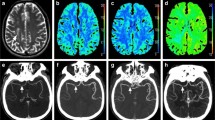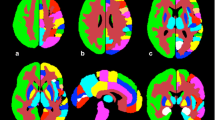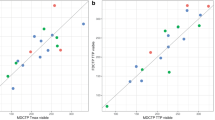Abstract
Objectives
To evaluate the accuracy and reproducibility of CT-perfusion (CTP) by finding the optimal artery for the arterial input function (AIF) and re-evaluating the necessity of the venous output function (VOF).
Methods
Forty-four acute ischaemic stroke patients who underwent non-enhanced CT, CTP and CT-angiography using 256-slice multidetector computed tomography (MDCT) were evaluated. The anterior cerebral artery (ACA), middle cerebral artery (MCA), internal carotid artery (ICA) and basilar artery were selected as the AIF. Subsequently the resulting area under the time–enhancement curve of the AIF (AUCAIF) and quantitative perfusion measurements were analysed by repeated measures ANOVA and subsequently the paired t test. To evaluate reproducibility we examined if the VOF could be deleted by comparing the perfusion measurements using versus not using the VOF (paired t test).
Results
The AUCAIF and perfusion measurements resulting from the different AIFs showed significant group differences (all P < 0.0001). The ICA had the largest AUCAIF and resulted in the highest mean transient time (MTT) and lowest cerebral blood flow (CBF), whereas the basilar artery showed the lowest cerebral blood volume (CBV). Not using the VOF showed significantly higher CBV and CBF in 66 % of patients on the ipsilateral (P < 0.0001 and P = 0.007, respectively) and contralateral hemisphere (P < 0.0001 and P = 0.019, respectively).
Conclusion
Selecting the ICA as the AIF and continuing the use of the VOF would improve the accuracy of CTP.
Key Points
• Perfusion imaging is an increasingly important aspect of multidetector computed tomography (MDCT).
• Vascular input functions were evaluated for CT-perfusion using 256-slice MDCT.
• Selecting different arterial input functions (AIFs) leads to variation in quantitative values.
• Using the internal carotid artery for AIF provides optimal perfusion values.
• Deleting the venous output function would be detrimental for validity.


Similar content being viewed by others
Abbreviations
- AIF:
-
arterial input function
- ACA:
-
anterior cerebral artery
- AUC:
-
area under the time–enhancement curve
- AUCAIF :
-
area under the time–enhancement curve of the AIF
- AUCVOF :
-
area under the time–enhancement curve of the VOF
- Hus:
-
Hounsfield units × seconds
- VOF:
-
venous output function
References
Wintermark M, Reichhart M, Thiran JP et al (2002) Prognostic accuracy of cerebral blood flow measurement by perfusion computed tomography, at the time of emergency room admission, in acute stroke patients. Ann Neurol 51:417–432
Miles KA, Lee TY, Goh V et al (2012) Current status and guidelines for the assessment of tumour vascular support with dynamic contrast-enhanced computed tomography. Eur Radiol 22:1430–1441
Bisdas S, Donnerstag F, Ahl B, Bohrer I, Weissenborn K, Becker H (2004) Comparison of perfusion computed tomography with diffusion-weighted magnetic resonance imaging in hyperacute ischemic stroke. J Comput Assist Tomogr 28:747–755
Nabavi DG, Cenic A, Henderson S, Gelb AW, Lee TY (2001) Perfusion mapping using computed tomography allows accurate prediction of cerebral infarction in experimental brain ischemia. Stroke 32:175–183
Rother J, Jonetz-Mentzel L, Fiala A et al (2000) Hemodynamic assessment of acute stroke using dynamic single-slice computed tomographic perfusion imaging. Arch Neurol 57:1161–1166
Wintermark M, Meuli R, Browaeys P et al (2007) Comparison of CT perfusion and angiography and MRI in selecting stroke patients for acute treatment. Neurology 68:694–697
Eastwood JD, Lev MH, Azhari T et al (2002) CT perfusion scanning with deconvolution analysis: pilot study in patients with acute middle cerebral artery stroke. Radiology 222:227–236
Turk AS, Grayev A, Rowley HA et al (2007) Variability of clinical CT perfusion measurements in patients with carotid stenosis. Neuroradiology 49:955–961
Zussman B, Jabbour P, Talekar K, Gorniak R, Flanders AE (2011) Sources of variability in computed tomography perfusion: implications for acute stroke management. Neurosurg Focus 30:E8
Soares BP, Dankbaar JW, Bredno J et al (2009) Automated versus manual post-processing of perfusion-CT data in patients with acute cerebral ischemia: influence on interobserver variability. Neuroradiology 51:445–451
Wintermark M, Ko NU, Smith WS, Liu S, Higashida RT, Dillon WP (2006) Vasospasm after subarachnoid hemorrhage: utility of perfusion CT and CT angiography on diagnosis and management. AJNR Am J Neuroradiol 27:26–34
Dankbaar JW, de Rooij NK, Rijsdijk M et al (2010) Diagnostic threshold values of cerebral perfusion measured with computed tomography for delayed cerebral ischemia after aneurysmal subarachnoid hemorrhage. Stroke 41:1927–1932
Kealey SM, Loving VA, Delong DM, Eastwood JD (2004) User-defined vascular input function curves: influence on mean perfusion parameter values and signal-to-noise ratio. Radiology 231:587–593
Sakai F, Nakazawa K, Tazaki Y et al (1985) Regional cerebral blood volume and hematocrit measured in normal human volunteers by single-photon emission computed tomography. J Cereb Blood Flow Metab 5:207–213
van der Schaaf I, Vonken EJ, Waaijer A, Velthuis B, Quist M, van Osch T (2006) Influence of partial volume on venous output and arterial input function. AJNR Am J Neuroradiol 27:46–50
Axel L (1983) Tissue mean transit time from dynamic computed tomography by a simple deconvolution technique. Investig Radiol 18:94–99
Ferreira RM, Lev MH, Goldmakher GV et al (2010) Arterial input function placement for accurate CT perfusion map construction in acute stroke. AJR Am J Roentgenol 194:1330–1336
Sanelli PC, Lev MH, Eastwood JD, Gonzalez RG, Lee TY (2004) The effect of varying user-selected input parameters on quantitative values in CT perfusion maps. Acad Radiol 11:1085–1092
Dorn F, Muenzel D, Meier R, Poppert H, Rummeny EJ, Huber A (2012) Brain perfusion CT for acute stroke using a 256-slice CT: improvement of diagnostic information by large volume coverage. Eur Radiol 21:1803–1810
Wintermark M, Flanders AE, Velthuis B et al (2006) Perfusion-CT assessment of infarct core and penumbra: receiver operating characteristic curve analysis in 130 patients suspected of acute hemispheric stroke. Stroke 37:979–985
Wintermark M, Lau BC, Chien J, Arora S (2008) The anterior cerebral artery is an appropriate arterial input function for perfusion-CT processing in patients with acute stroke. Neuroradiology 50:227–236
Kamath A, Smith WS, Powers WJ et al (2008) Perfusion CT compared to H(2) (15)O/O (15)O PET in patients with chronic cervical carotid artery occlusion. Neuroradiology 50:745–751
Calamante F, Morup M, Hansen LK (2004) Defining a local arterial input function for perfusion MRI using independent component analysis. Magn Reson Med 789–797
Sheikh K, Schipper MJ, Hoeffner EG (2009) Feasibility of superficial temporal artery as the input artery for cerebral perfusion CT. AJR Am J Roentgenol 192:W321–W329
Lee TY (2002) Functional CT: psychological models. Trends Biotechnol 20:s3–s10
Bisdas S, Konstantinou GN, Gurung J et al (2007) Effect of the arterial input function on the measured perfusion values and infarct volumetric in acute cerebral ischemia evaluated by perfusion computed tomography. Investig Radiol 42:147–156
Chiu FY, Teng MM, Kao YH, et al (2012) Selection of arterial input function for postprocessing of cerebral ct perfusion in chronic unilateral high-grade stenosis or occlusion of the carotid or middle cerebral artery. Acad Radiol 19:8–16
Wu O, Ostergaard L, Weisskoff RM, Benner T, Rosen BR, Sorensen AG (2003) Tracer arrival timing-insensitive technique for estimating flow in MR perfusion-weighted imaging using singular value decomposition with a block-circulant deconvolution matrix. Magn Reson Med 50:164–174
Sasaki M, Kudo K, Ogasawara K, Fujiwara S (2009) Tracer delay-insensitive algorithm can improve reliability of CT perfusion imaging for cerebrovascular steno-occlusive disease: comparison with quantitative single-photon emission CT. AJNR Am J Neuroradiol 30:188–193
Smith MR, Lu H, Trochet S, Frayne R (2004) Removing the effect of SVD algorithmic artifacts present in quantitative MR perfusion studies. Magn Reson Med 51:631–634
Abels B, Villablanca JP, Tomandl BF, Uder M, Lell MM (2012) Acute stroke: a comparison of different CT perfusion algorithms and validation of ischaemic lesions by follow-up imaging. Eur Radiol. doi:10.1007/s00330-012-2529-8
Acknowledgements
This study was supported by grants from the Dutch Heart Foundation (grant 2008T034) and NutsOhra Foundation (grant 0903-012).
Author information
Authors and Affiliations
Corresponding author
Rights and permissions
About this article
Cite this article
Niesten, J.M., van der Schaaf, I.C., Riordan, A.J. et al. Optimisation of vascular input and output functions in CT-perfusion imaging using 256(or more)-slice multidetector CT. Eur Radiol 23, 1242–1249 (2013). https://doi.org/10.1007/s00330-012-2731-8
Received:
Revised:
Accepted:
Published:
Issue Date:
DOI: https://doi.org/10.1007/s00330-012-2731-8




